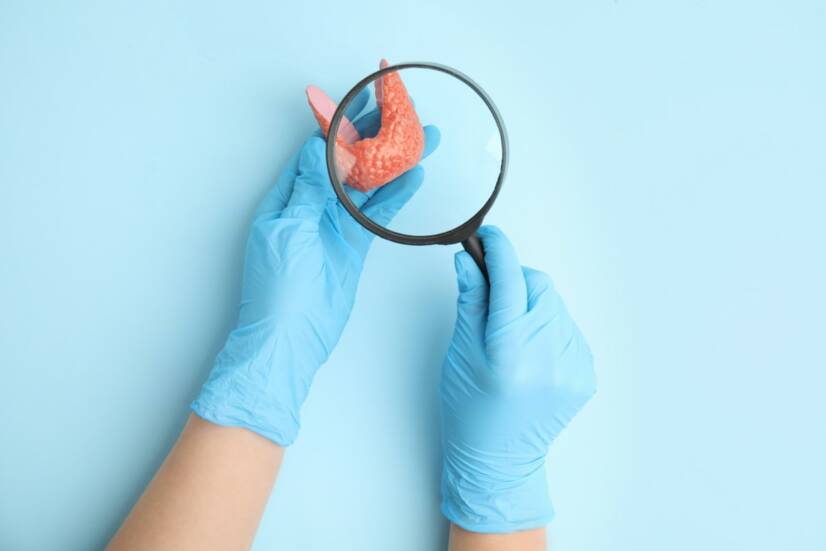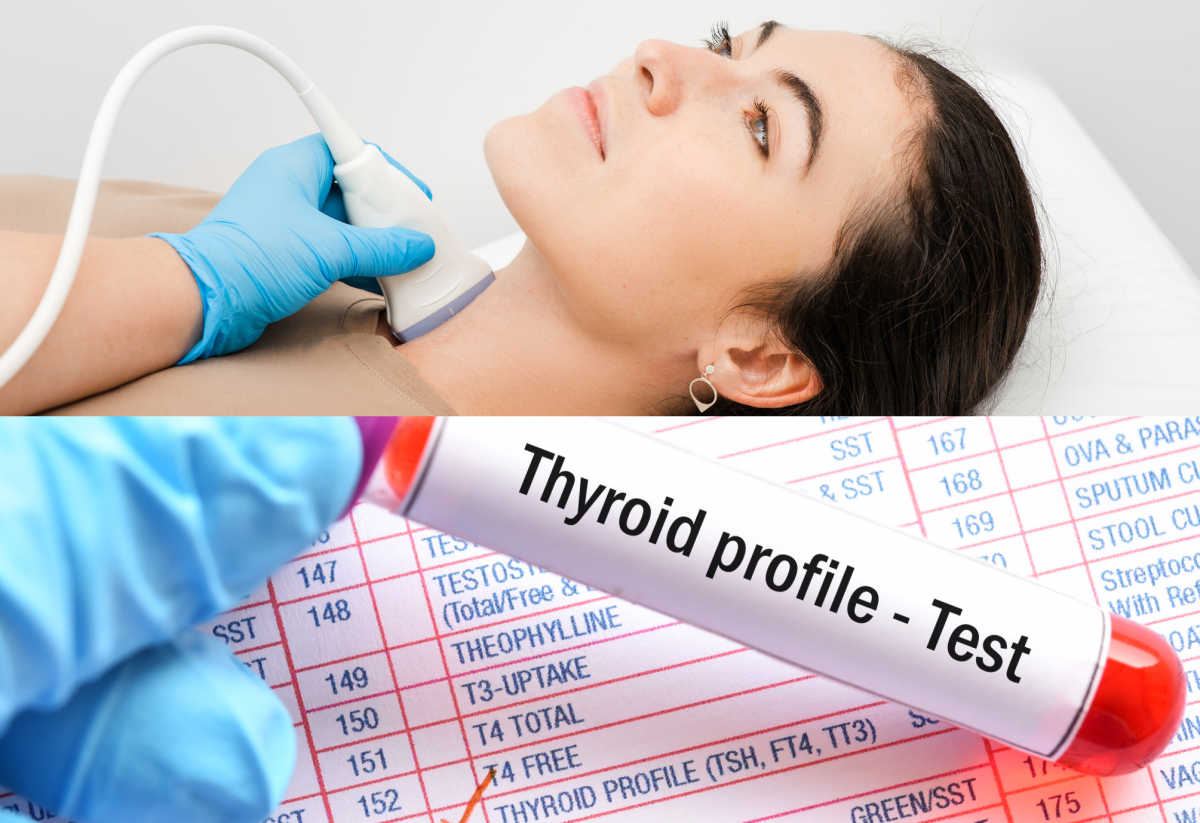- solen.sk - DISORDERS OF THYroid Gland Function in GRAVIDITES - THEIR CONSEQUENCES, RECOGNITION AND TREATMENT, Peter Hnilica, Endocrinology Outpatient Clinic, St. Elizabeth Cancer Institute, Bratislava
- solen.cz - TYREOTOXICITY AND THE IMPACT OF TYREOID HORMONES ON BONE FAT, Karel Starý, Dr., Internal Gastroenterology Clinic, Faculty of Medicine, Medical University of Brno, Vítězslav Ruber, Dr., Department of Trauma Surgery, Faculty of Medicine, Medical University of Brno, Milan Dastych, Dr., Internal Gastroenterology Clinic, Faculty of Medicine, Medical University of Brno.
- zona.fmed.uniba.sk - Thyroid gland
- mayoclinic.org - Hyperthyroidism (overactive thyroid gland)
- pubmed.ncbi.nlm.nih.gov - Hyperthyroidism
- pubmed.ncbi.nlm.nih.gov - Graves' disease
Thyrotoxicosis and thyroiditis: what is it and what are the causes, symptoms?

Thyrotoxicosis is a consequence of excessive action of thyroid hormones on the human organism. Why does it arise and how does it manifest itself?
Most common symptoms
- Sweating
- Eye Pain
- Sensitivity to light
- Double vision
- Diarrhoea
- Brittle nails - onychoschizia
- Brittle hair
- Eye irritation
- Menstrual cycle disorders
- Tremor
- Muscle weakness
- Itchy eye
- Fatigue
- Anxiety
- Bulging eyes
- Redness of the conjunctivae
- Deterioration of vision
- Accelerated heart rate
- Increased appetite
- Increased watery eye
Characteristics
Hyperthyroidism is a pathological condition in which the thyroid gland produces too much of its hormones, especially thyroxine.
Hyperthyroidism causes the so-called hypermetabolic syndrome, which is characterized by rapid weight loss and a fast, irregular heartbeat.
What is hyperthyroidism and thyrotoxicosis?
Hyperthyroidism is a condition caused by excessive activity of the thyroid gland, which produces the thyroid hormones triiodothyronine (T3) and thyroxine (T4).
Thyrotoxicosis is a set of clinical symptoms that result from the action of excessive amounts of thyroid hormones on the tissues of the human body.
How is the thyroid gland regulated?
Thyroid activity is regulated by the pituitary gland and hypothalamus, by a hormone called thyrotropic hormone (TSH).
This hormone is produced in the hypothalamus and stored in the adenohypophysis. After its secretion, the thyroid gland is stimulated to act and produce its own hormones.
The main product of the thyroid gland is...
The main product of the thyroid gland is thyroxine. However, this hormone is only a precursor for the production of triiodothyronine. These hormones bind to plasma proteins in the blood.
Only the free fractions, abbreviated as fT3 and fT4, enter the cells.
Where are these hormones applied everywhere?
Thyroid hormones have many important roles in the body. Their effects affect the fetus as early as in utero and especially during the development of the brain, spinal cord and skeleton.
Other effects of thyroid hormones:
- they speed up the heart rate and increase the pulse
- maintain proper lung function and breathing
- promote bowel movements
- have a positive effect on the production of red blood cells
- also affect other hormones, e.g. growth hormone, sex hormones, adrenal hormones
- accelerate the metabolism of sugars and fats
- stimulate bone turnover
- maintain proper skeletal muscle function
Causes
The most common causes include the following conditions:
- Graves-Basedow disease (60-85% of cases).
- Multinodular goiter (10-30%)
- Unilocular goiter - toxic adenoma (2-10%)
- Drug-induced hyperthyroidism (e.g. amiodarone, iodine)
- With excessive use of iodine by the patient - Thyrotoxicosis factitia,
- Thyroiditis - inflammation of the thyroid gland (subacute, hashitoxicosis)
- Hyperthyroidism during pregnancy and after childbirth (postpartum)
- Iatrogenic - after treatment or surgery
- Excessive TSH secretion (e.g., pituitary tumor, TSH resistance)
- Ovarian goiter
- Thyroid cancer
Graves-Basedow disease
Among the most common causes of hyperthyroidism.
It primarily affects women and 4 to 5 times more often than men, especially between the second and fourth decades of life.
It is an autoimmune disease. Autoantibodies are formed in the body that activate the thyrotropin receptor (the receptor to which TSH binds). When such autoantibodies bind to the TSH receptor, the thyroid gland is automatically stimulated to produce hormones.
The pituitary gland responds with a reduced secretion of its hormone TSH. But the thyroid gland still produces high levels of hormones because it is stimulated by autoantibodies.
These autoantibodies also bind to antigens in other parts of the body, for example behind the eyeballs, in the subcutaneous tissue of the shins, on the hands and feet. Graves-Basedow disease therefore has other characteristic symptoms besides thyrotoxicosis, such as endocrine orbitopathy, pretibial myxedema or acropachia.
In addition to these symptoms, diffuse goiter - that is, marked enlargement of the thyroid gland - predominates.
Struma nodularis (nodular goiter)
Struma is a term referring to painless enlargement of the thyroid gland above the volume norm.
The normal volume of the thyroid gland is approximately 18-22 ml.
Again, there are several causes of thyroid enlargement. In nodular goiter, nodules or lumps form inside the organ, most often filled with fluid.
Struma ovarii
Struma ovarii is one of the very rare diseases. It is caused by so-called ectopic thyroid tissue, which is located in the ovaries.
It is a form of so-called teratoma.
A teratoma is a tumor that was formed during embryonic development. As the tissues of all the organs developed and the cells migrated to their proper places, some "wandered" to the wrong place and nested there.
This is how the thyroid tissue got into the ovary, which has the full function of a thyroid gland and can produce all the hormones as a true thyroid gland.
The result of dual hormone production is hyperthyroidism.
Hyperthyroidism in pregnancy and after childbirth
During pregnancy, hyperthyroidism is quite common and in many cases harmless.
It is caused by the effect of the "pregnancy hormone" hCG (human chorionic gonadotropin) on the thyroid tissue during the first trimester. The result can be so-called non-autoimmune pregnancy hyperthyroidism, which is often accompanied by excessive vomiting.
This condition tends to resolve spontaneously over time and does not require treatment.
Another common condition is postpartum thyroiditis, i.e. inflammation of the thyroid gland. This is an autoimmune disease in which antibodies are formed that destroy thyroid tissue. Hormones are leached from the broken cells, causing thyrotoxicosis.
This disease manifests itself most often within six months of birth.
At first, thyrotoxicosis is present, caused by the leaching of hormones. In about 40% of cases, the disease progresses (after 1-2 months) to the next stage, namely hypothyroidism.
Hypothyroidism (reduced thyroid function) is caused by tissue destruction and its absence.
It is manifested by muscle pain and depression.
Symptoms
The set of symptoms of thyrotoxicosis is called hypermetabolic syndrome and includes:
- Unintentional weight loss, weight loss continues even after increasing energy intake or in the absence of exercise
- Rapid heart rate called tachycardia (more than 100 beats per minute)
- Irregular heart rhythm - arrhythmias, e.g. fibrillation
- Feeling the heart pounding - palpitations
- Increased food intake
- Nervousness, anxiety and irritability
- Shaking of hands and fingers
- Increased sweating
- Irregular menstrual cycle
- Heat intolerance
- Frequent diarrhea
- Enlarged thyroid gland
- Increased fatigue
- Muscle weakness
- Difficulty falling asleep and frequent waking
- Deterioration of skin quality
- Fine, brittle hair
- Brittle nails
In older patients, the absence of some symptoms or having a milder course is common.

Graves' ophthalmopathy
A well-known symptom in thyrotoxicosis is the so-called Graves' ophthalmopathy, which affects the eyes.
The risk is increased in those patients who smoke.
In Graves' ophthalmopathy, the eyeballs are markedly enlarged and bulging. This is caused by swelling of the tissues and muscles behind the eyes.
Symptoms of Graves' ophthalmopathy include:
- large bulging eyes
- dryness of the conjunctivae
- redness of the eyes
- swelling
- excessive tearing
- foreign body sensation in the eyes
- slight pallor
- blurred or double vision
- restricted eye movement
Diagnostics
On objective examination, the physician may notice trembling of the fingers when bending the hands, lively tendon-skeletal reflexes, large shiny eyes or warm sweaty skin.
On palpation of the thyroid gland on the neck, the thyroid gland is enlarged, and may "jump" when swallowing. Sometimes the thyroid gland is lumpy or painful.
Another diagnostic test is an ECG of the heart, which may show an irregular heart rhythm or rapid heart rate.
Blood tests and T3 + T4 + TSH values in the table
Thyroid hormone levels are analysed from a blood sample taken.
High levels of thyroxine (T4) and low levels of TSH are a sign of an overactive thyroid gland.
TSH levels are important. This hormone secreted from the pituitary gland "sends" a signal to the thyroid gland to produce more thyroxine. If there is too much thyroxine, the feedback loop will reduce TSH secretion.
The reduction in TSH informs the thyroid to slow down the production and secretion of thyroxine.
If both high thyroxine and high TSH levels are found in blood tests, this is central hyperthyroidism.
In central hyperthyroidism, the feedback control loop between the thyroid and pituitary is dysfunctional.
High thyroxine levels do not cause a decrease in TSH secretion, therefore the pituitary produces large amounts of TSH and the thyroid produces large amounts of thyroxine.
Other blood parameters that support the diagnosis of hyperthyroidism are:
- high bilirubin levels
- reduced neutrophil count
- reduced platelet count
- increased bone turnover
- elevated liver function tests
- low calcium and parathyroid hormone levels
The table shows the reference values for fT3 - free triiodothyronine
| Age | Women - pmol/l | Men - pmol/l |
| 0-1 month | 5-7,5 | 4,6-10,1 |
| 1 month to 1 year | 4,3-7,6 | 4,3-7,5 |
| 1 to 5 years | 4,3-7,6 | 4,0-8,1 |
| 5-10 years | 4,2-7,6 | 4,1-7,5 |
| 10-14 years | 3,5-7,3 | 4,6-7,2 |
| 14-18 years | 3,5-6,9 | 4,2-7,5 |
| Adults | 3,5-6,5 | 3,7-6,6 |
The table shows the reference values for fT4 - free thyroxine
| Age | Values in pmol/l |
| within 1 month | 8,5-30,5 |
| 1 month to 1 year | 9,2-25,3 |
| 1-5 years | 10,5-22,4 |
| 5-10 years | 10,6-20,9 |
| 10-14 years | 10,4-21,4 |
| 14-18 years | 10,6-22,6 |
| Adults | 10,5-22,7 |
The table shows reference values for TSH - thyroglobulin/thyroid stimulating hormone/thyroidotropic hormone
| Period | Value in mIU/l |
| within 1 month | 0,7-16,8 |
| 1 month to 1 year | 1,1-8,2 |
| 1-5 years | 0,8-6,3 |
| 5-10 years | 0,8-5,4 |
| 10 years and more | 0,35-5,1 |
| In pregnancy | 0,27-4,2 |
Reference values may vary slightly depending on the laboratory.
Thyroid ultrasound
Ultrasound is the most accessible imaging test of the thyroid gland.
It has the advantage that the patient is not burdened by radioactive or ionising radiation. It is also used to differentiate nodular goitre or to examine the lymph nodes of the thyroid gland, e.g. when cancer is suspected.

Radioiodine uptake examination
This special test determines how much iodine the thyroid gland is able to take up.
After taking a small tablet of radioactive iodine (radioiodine), the thyroid gland is monitored at intervals of four, six or 24 hours.
A high intake of radioactive iodine is a sign of an overactive thyroid and increased thyroxine production.
If hyperthyroidism is noted but the radioiodine uptake test is negative, it means that thyroxine, which is stored in the thyroid gland, is leaking into the bloodstream. Thus, it may be an inflammatory thyroid disease, i.e. thyroiditis.
Course
Symptoms of thyrotoxicosis are often very mild and escape the eye of the doctor.
In such cases, the disease remains undiagnosed for years. It is detected only when the condition decompensates, which may be very acute under the picture of a thyrotoxic crisis.
Thyrotoxic crisis is a life-threatening condition that requires hospitalization of the patient with monitoring of vital signs in the intensive care unit.
Thyrotoxic crisis
A thyrotoxic crisis is a life-threatening condition that occurs after an escalation of untreated thyrotoxicosis, i.e. hyperthyroidism.
Decompensation of the condition often occurs after infection, major surgery or trauma. A thyrotoxic crisis can also occur if the patient stops taking medication to treat hyperthyroidism or takes too many iodine-containing preparations.
Symptoms of thyrotoxic crisis include:
- High fever (> 40 °C or more)
- Changes in psyche and consciousness (delirium, hallucinations, drowsiness, convulsions, coma)
- Diarrhoea
- Nausea, vomiting and abdominal pain
- Yellowing of the whites of the eyes and skin
- Rapid pulse
- Heart rhythm disturbances (atrial fibrillation)
- Pulmonary oedema
A patient in thyrotoxic crisis must be admitted to the intensive care unit with monitoring of all vital signs.
The first choice treatment is thyreostatic drugs, beta blockers and corticosteroids. Hydration, administration of vitamins or antibiotics are an important part of the treatment.
In some cases, the patient must undergo thyroidectomy.
How it is treated: Thyrotoxicosis
Treatment of thyrotoxicosis: medication, radioactive iodine or surgical form
Show moreThyrotoxicosis is treated by
Other names
Interesting resources










